Tango mango y tequila

 On Sunday, there was a milonga scheduled at the Cha-3 near the Paseo de Florida. I made my way there, by metro and by foot, but already as I exited the metro station, it was clear to me that this perfect Sunday afternoon was no time to be spending indoors. The Paseo de Florida itself is a nice pleasant avenue to stroll along, despite the ongoing obras (construction). It was approaching lunchtime, and the many cervecerias and restaurants were beginning to fill up. I enjoyed seeing the artwork celebrating beer that ornamented these establishments, such as those shown here.
On Sunday, there was a milonga scheduled at the Cha-3 near the Paseo de Florida. I made my way there, by metro and by foot, but already as I exited the metro station, it was clear to me that this perfect Sunday afternoon was no time to be spending indoors. The Paseo de Florida itself is a nice pleasant avenue to stroll along, despite the ongoing obras (construction). It was approaching lunchtime, and the many cervecerias and restaurants were beginning to fill up. I enjoyed seeing the artwork celebrating beer that ornamented these establishments, such as those shown here. I decided to head from the Estación del Norte, which stands next to the Princípe Pío subway at the beginning of Florida, toward the Ópera. I made my way through some nice parks and gardens, and ended up at an enormous plaza that stood before a monumental structure, which the map indicated was the Palácio Reál. I was delighted to hear the strains of tango music--it was Danzarín by Troilo--coming from not too far ahead. Four young Argentines were giving a Sunday afternoon tango display just opposite the Palace. In the photo below, my back is to the Palace, and behind the dancers, on the right, you can see the Madrid opera house.
I decided to head from the Estación del Norte, which stands next to the Princípe Pío subway at the beginning of Florida, toward the Ópera. I made my way through some nice parks and gardens, and ended up at an enormous plaza that stood before a monumental structure, which the map indicated was the Palácio Reál. I was delighted to hear the strains of tango music--it was Danzarín by Troilo--coming from not too far ahead. Four young Argentines were giving a Sunday afternoon tango display just opposite the Palace. In the photo below, my back is to the Palace, and behind the dancers, on the right, you can see the Madrid opera house.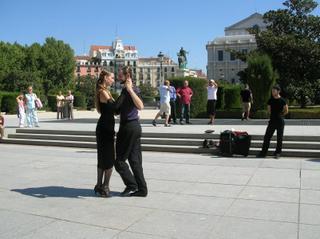
Near the Ópera, I came across Reál Musical, a well-known music shop in Madrid. In its windows, the guitars were naturally prominently featured. Iberian culture (and by extension, Latin American culture) is the most guitar-rich in the world, and the Iberian fascination with lutes (that is the family to which the guitar belongs to) seems to have its origin during the Moorish period, when Middle Eastern stringed instruments were introduced and took hold. The guitar itself was a development over a number of centuries, from the original laúd (a variant of the Arabic al 'ud) to the Renaissance vihuela to the modern Spanish guitar, which reached its present form in the early 19th century. The rich varieties of guitar (or lute) in Latin America, from the diminutive Brazilian cavaquinho to the enormous Mexican guitarrón, are a living part of this cultural heritage.

Walking further, I arrived at the Plaza de Isabel II, where I was able to capture the felicitous juxtaposition of old and new symbols below.
My walk took me through more charming squares and finally to the Gran Via. I decided to make my way toward the northeast, where there was a curio shop I had read about. It was Sunday, and most shops were of course closed. I nonetheless wanted to continue the walk.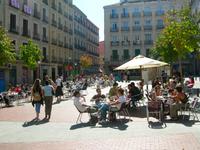 In the vicinity of the shop I found another nice square where people were having their lunch outdoors. There were several interesting restaurants in the area, and I decided on one of the several Mexican restaurants, mainly because of the interesting decor--the walls were filled with colorful murals, of which I show a section here:
In the vicinity of the shop I found another nice square where people were having their lunch outdoors. There were several interesting restaurants in the area, and I decided on one of the several Mexican restaurants, mainly because of the interesting decor--the walls were filled with colorful murals, of which I show a section here:
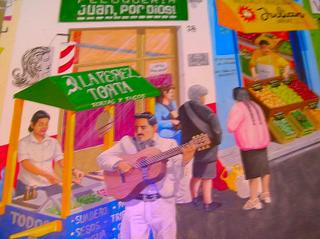
The food offerings were interesting, and good. For dessert, I had the mango + tequila sorbet:
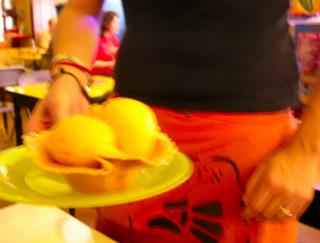
Which will conclude the report on this particular domingo in Madrid. The next entry will include photos from Valladolid. Stay tuned.
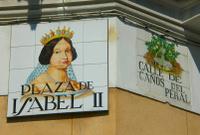
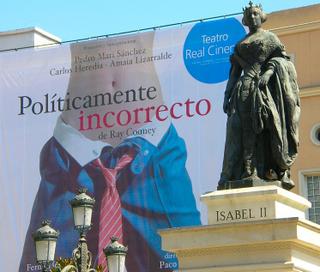

1 Comments:
Mmmmmm-mmmmm MMMMMango!
Post a Comment
<< Home